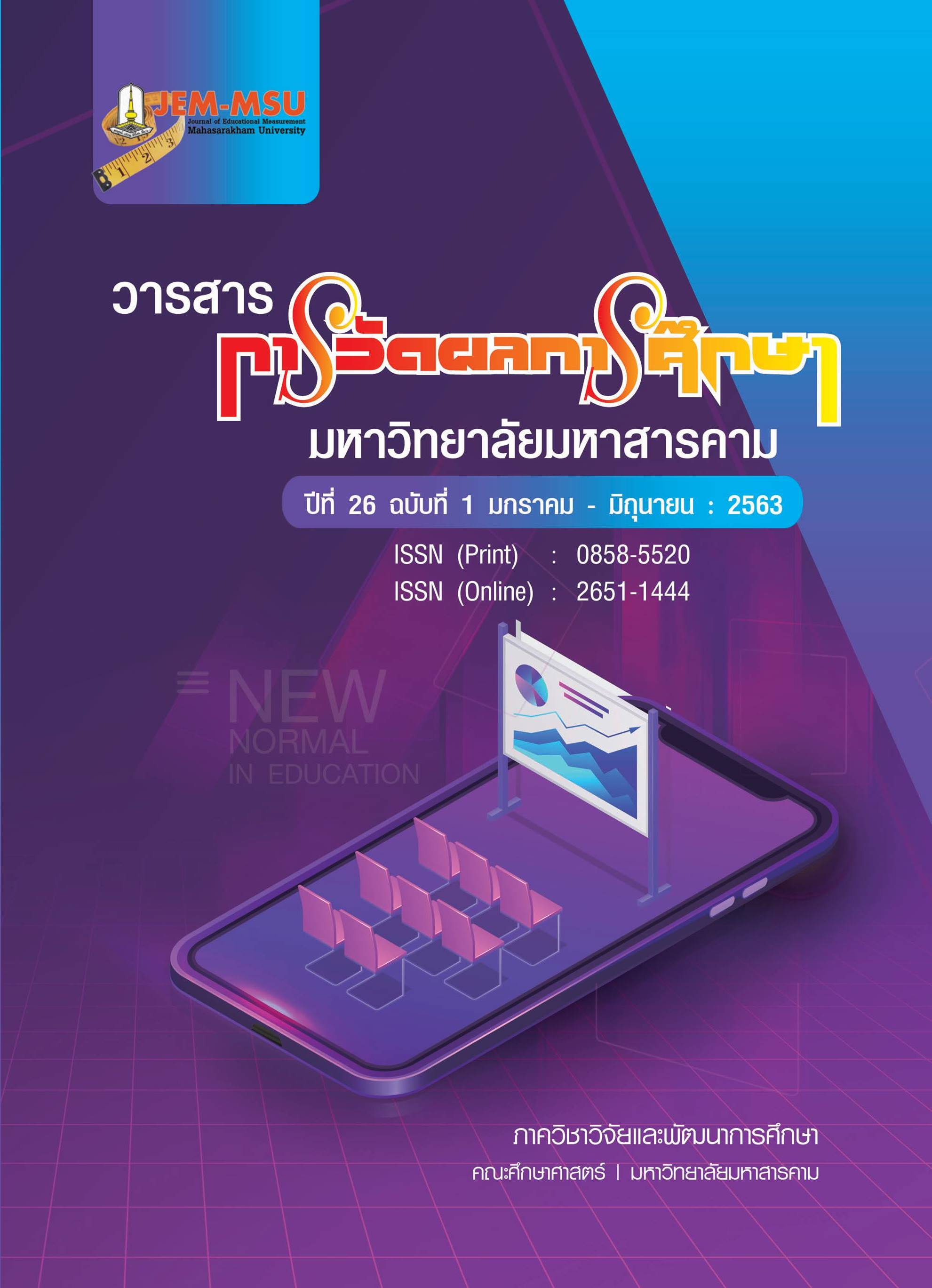The Study of Effects of Development of Measurement and Evaluation System via Web Application in Municipal Schools of the Local Administration Organization
Main Article Content
Abstract
The objectives of this study were to 1) study efficiency of the measurement and evaluation system via web application in municipal schools of the local administration organization and 2) study the users’ satisfaction with the measurement and evaluation system via web application in municipal schools of the local administration organization. The research methodology was the survey method. The target group consisted of 7 experts in educational technology, computer studies, and measurement and evaluation, and 44 teachers using the system. The research instruments consisted of 1) the measurement and evaluation system via web application for municipal schools of the local administration organization, 2) a system efficiency evaluation form for the experts, which contained multiple choices and a cloze section, and 3) a 5-point rating scale satisfaction questionnaire for the teachers. Analysis of data employed frequency, percentage, the mean and standard deviation.
The results of the study revealed that:
1. The experts evaluated the efficiency of the measurement and evaluation system via web application in the municipal schools of the local administration organization and found that the system functioned properly and fast, and it was convenient and easy to use. The system user’s guide had its efficiency in the highest level on all items. Regarding appropriateness in the system operation and security, most items were evaluated as having the highest level of efficiency, except the error notification (71.40 percent) and the user control allowing users to use the system according to their rights correctly (71.40 percent). These 2 items had their efficiency in the high level.
2. The users’ satisfaction with the measurement and evaluation system via web application in the municipal schools of the local administration organization, as a whole, was in the high level (elementary school teachers: M = 4.24, secondary school teachers: M = 3.98, and teachers who were system administrator: M = 4.26).
Article Details
The content and information contained in the published article in the Journal of Educational Measurement Mahasarakham University represent the opinions and responsibilities of the authors directly. The editorial board of the journal is not necessarily in agreement with or responsible for any of the content.
The articles, data, content, images, etc. that have been published in the Journal of Educational Measurement Mahasarakham University are copyrighted by the journal. If any individual or organization wishes to reproduce or perform any actions involving the entirety or any part of the content, they must obtain written permission from the Journal of Educational Measurement Mahasarakham University.
References
ชัญญา พงษ์ชัย, ธนีนาฎ ณ สุนทร และภัทรพล มหาขันธ์. (2554). ปัญหาและแนวทางแก้ไขการบริหารงานวิชาการในโรงเรียนประถมศึกษาขนาดเล็กสำนักงานเขตพื้นที่การศึกษาประถมศึกษาสระบุรี เขต 2. วารสารบัณฑิตศึกษา มหาวิทยาลัยราชภัฏวไลยอลงกรณ์ ในพระบรมราชูปถัมภ์, 5(3), 31-41.
รัชนีวรรณ ตั้งภักดี, และคณะ. (2561). คู่มือการใช้งาน Web Application & Mobile Application ระบบวัดและประเมินผลโรงเรียนเทศบาลวัดสระทอง. สืบค้นจาก https://www.srathong.ac.th/evaluation
ศิริชัย กาญจนวาสี. (2548). ทฤษฎีการประเมิน. กรุงเทพ: จุฬาลงกรณ์มหาวิทยาลัย.
สมชาย รัตนทองคํา. (2554). การสอนทางกายภาพบําบัด.กรุงเทพฯ.มหาวิทยาลัยขอนแก่น.
สุพิชญา อาชวิรดา. (2559). ปัจจัยที่ส่งผลต่อระดับการรักษาความมั่นคงปลอดภัยของระบบสารสนเทศในองค์กร. วารสารระบบสารสนเทศด้านธุรกิจ (JISB), 2(2), 66.
อำไพ พรประเสริฐสกุล. การวิเคราะห์และออกแบบระบบ (System Analysis and Design).กรุงเทพมหานคร : บริษัทออฟเซท-เพรส จำกัด, 2543.
Cisco. (2008). 10 พฤติกรรมสุดเสี่ยงข้อมูลองค์กรรั่วไหล. สืบค้นจาก https://www.cisco.com/web/ TH/about/news/2008/20081009_secure.html
Kenneth E. & Julie E. Kendall. (2005). Systems Analysis and Design, 6 th (ed) Upper Saddle River, Prentice Hall
Mind php. (2018). Web Application เว็บ แอพพลิเคชั่น คืออะไร. สืบค้นจาก https://mindphp.com/ AD/73A3/3664-web-application- A3.html


